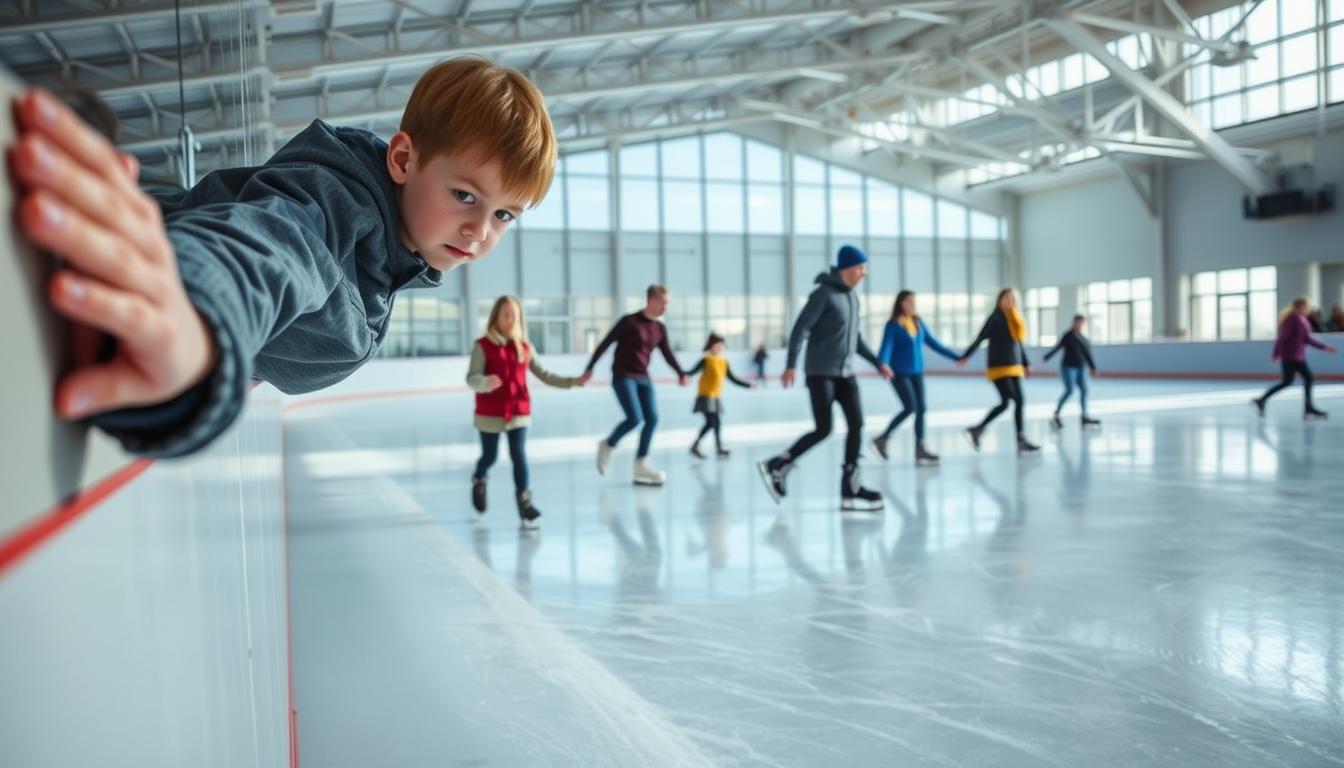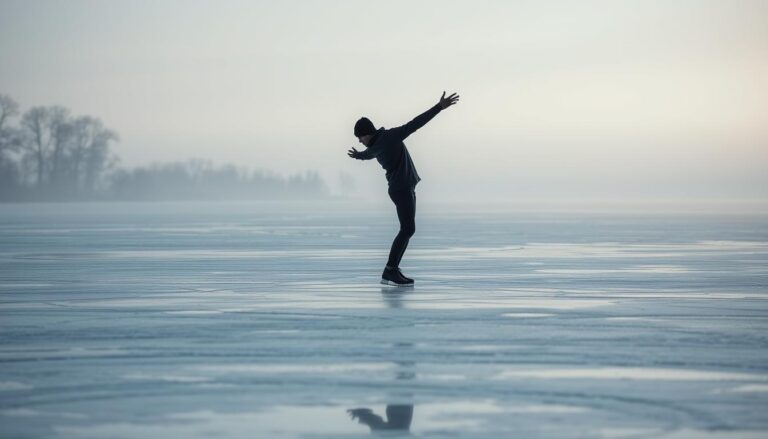How Hard is Ice Skating? Tips for New Skaters
Ice skating might seem scary at first, but it’s a fun sport to learn. Is ice skating hard? Not really! With patience and the right moves, you’ll glide on the ice easily and feel great about it.
Getting started with ice skating is all about being ready mentally. Your first steps will be shaky, but that’s okay. Experts say confidence grows with practice, not being perfect. Tips for beginners often focus on getting past your fears and learning to balance and move.
Ice skating is easier to learn than you might think. You can go at your own speed, unlike some sports. You’ll start with basic moves like staying balanced, moving forward, and stopping. Each step you take will make you more confident and skilled.
Being physically fit is important for skating. You’ll need strong core, balance, and flexibility to improve fast. Even if you’re not athletic, skating is a great workout that will boost your fitness.
Always put safety first when you start skating. Wear the right gear, like good skates, helmets, and padding. Tips for beginners always suggest taking lessons from experts who teach you how to skate safely and correctly.
Ice skating is for everyone, no matter your age. Whether you’re 7 or 70, you can start this fun sport. With hard work, practice, and the right attitude, you’ll go from being a beginner to a confident skater who loves gliding on the ice.
Are you ready to try it? Ice skating is a journey filled with learning and fun. Be kind to yourself, and remember that every pro skater began where you are now – at the start, full of determination and excitement.
Understanding the Basics of Ice Skating
Starting ice skating can seem scary for beginners. Knowing the basics helps you feel more confident on the ice. This guide will cover the key things every new skater should know.
Essential Equipment for Beginners
Choosing the right gear is important for beginners. The right equipment can make your skating experience better. Here’s what you’ll need:
- Skates: Rent or buy ice skates that fit well and support your feet
- Wear warm, comfy clothes that let you move freely
- Put on thick socks to avoid blisters
- Wear protective gear like a helmet, wrist guards, and knee pads
Proper Skating Posture
Getting the right stance is key to making ice skating easier. Here are some tips to help you:
- Keep your knees slightly bent
- Lean forward a bit
- Keep your arms relaxed by your sides
- Keep your head up and look forward
Basic Safety Guidelines
Always put safety first when you’re learning to ice skate. Follow these important rules to stay safe:
- Start on public skating sessions when it’s less busy
- Be aware of what’s happening around you
- Learn how to fall safely to avoid getting hurt
- Practice near the rink’s edge for support
Remember, every pro skater began where you are now. With patience, practice, and a positive attitude, you’ll skate confidently soon.
Is Ice Skating Hard? Breaking Down the Learning Curve
Learning ice skating might seem tough at first, but it’s easier than many think. Many beginners wonder if ice skating is hard. But with the right approach, anyone can learn to skate.
The learning curve for ice skating depends on several key factors:
- Individual physical fitness
- Age and flexibility
- Previous balance-related experience
- Personal confidence
Mastering ice skating means understanding that initial challenges are normal. Your body will gradually adapt to the unique sensation of gliding on ice. Beginners go through distinct stages of skill development.
Some essential aspects that impact ice skating difficulty include:
- Balance and core strength
- Muscle memory development
- Coordination and spatial awareness
- Mental preparation and overcoming fear
Professional instructors often recommend starting with basic techniques and gradually building confidence. Most learners find that persistent practice turns initial struggles into enjoyable experiences.
Remember, everyone learns differently. Your journey on the ice will be unique. With patience and commitment, you can see rapid improvement.
Getting Started: First Steps on Ice
Learning to ice skate is an exciting journey. It turns nervous beginners into confident skaters. Your first moments on the ice are key to learning the basics.
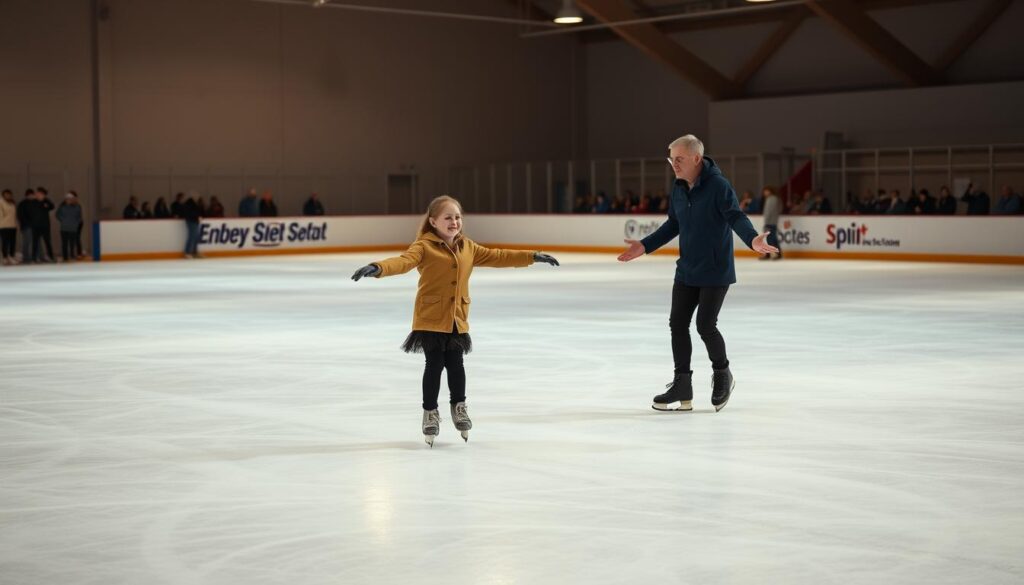
Stepping onto the ice takes courage and preparation. Make sure you have the right skates and protective gear. The right gear boosts your confidence and helps you learn better.
Mastering Your Balance
Balance is essential for ice skating. Start by finding your body’s center of gravity. Here are some balancing tips:
- Keep your knees slightly bent for better stability
- Maintain an upright posture with your head aligned over your body
- Spread your feet shoulder-width apart
- Look forward, not down at your feet
Forward Marching Technique
Forward marching is your first real move on the ice. It builds your confidence and control. Think of it as walking, but on ice. Lift each foot alternately, pushing off to move forward.
Gliding Fundamentals
When you’re comfortable marching, you’ll start gliding. Gliding is the core of ice skating. Start by pushing off with one foot, sliding on the other. Practice keeping your balance during these glides.
Remember, every expert skater started where you are now. Be patient and keep practicing. Your wobbles will soon turn into smooth movements.
Common Challenges for Beginning Skaters
Ice skating for beginners is like trying to skate on a slippery surface. Every new skater faces unique challenges that test their will and strength. But, with each challenge, they grow more confident and skilled.
Let’s look at the most common ice skating hurdles:
- Balance Struggles: Your first moments on ice will likely feel wobbly and uncertain
- Fear of Falling: The fear of slipping can be a big mental block
- Muscle Coordination: It takes practice to move smoothly on the ice
- Stopping Techniques: Learning to stop safely takes a lot of practice
Knowing these challenges helps you set realistic goals. Instructors say to see every fall as a chance to learn. The secret is to keep practicing and stay positive.
Mental preparation is key to beating ice skating challenges. Using visualization and learning skills little by little can really help. Start with small goals, celebrate each step forward, and remember that every pro started where you are.
- Wear protective gear to reduce falling anxiety
- Take beginner lessons from qualified instructors
- Practice balance exercises off the ice
- Watch tutorial videos to understand proper techniques
Your ice skating journey is all about learning and growing. Every challenge you conquer brings you closer to enjoying the sport.
Essential Ice Skating Techniques for Newcomers
Learning ice skating techniques is key to feeling confident on the ice. As a beginner, focus on basic skills for smooth and safe gliding. Understanding and practicing these movements is essential.
Here are the main ice skating techniques to help you go from a nervous beginner to a confident skater:
Forward Skating Fundamentals
Forward skating is the base of ice skating. To get better:
- Maintain a slight bend in your knees
- Keep your weight centered over your skating foot
- Push off with the inside edge of your blade
- Use smooth, rhythmic movements
Mastering Stopping Methods
Being able to control your speed is vital for safe skating. Here are two main stopping methods:
| Stopping Method | Key Technique | Difficulty Level |
|---|---|---|
| Snowplow Stop | Push heels outward, create a pizza slice shape | Beginner |
| T-Stop | Drag one foot perpendicular behind the other | Intermediate |
Basic Turning Techniques
Turning is a key skill in ice skating. Start with these simple techniques:
- Look in the direction you want to turn
- Shift your weight slightly to the inside edge
- Rotate your upper body gently
- Practice C-shaped turning movements
Practice these techniques often to build muscle memory and confidence. Remember, every expert started where you are now – learning the basics with determination and patience.
Building Confidence on Ice

Mastering ice skating is not just about physical skill. It also requires a strong mental approach. Every skater, from beginners to pros, faces self-doubt on the ice.
Building confidence takes time and involves several strategies:
- Embrace a positive mindset
- Set realistic goals
- Practice visualization techniques
- Celebrate small victories
Mental preparation is key in your ice skating journey. Visualization is a powerful tool that can help you overcome fear and improve your performance. Imagine yourself gliding smoothly, executing perfect moves, and feeling completely comfortable on the ice.
| Confidence-Building Strategy | Impact on Skating |
|---|---|
| Positive Self-Talk | Reduces anxiety, improves focus |
| Goal Setting | Provides clear direction, motivation |
| Regular Practice | Builds muscle memory, increases skill |
Falling is a normal part of learning. Even pros fall many times before mastering their skills. Each fall is a chance to learn and grow. Start with small challenges and gradually push your comfort zone.
Your confidence on ice will grow as you get more comfortable with the basics. Take lessons, practice regularly, and be patient with yourself. Overcoming ice skating challenges is a journey of personal growth and skill development.
Physical Fitness Requirements for Ice Skating
Mastering ice skating is more than just practicing on the ice. Your physical fitness is key to becoming a confident skater. The right physical attributes can make your skating experience exciting and rewarding.
Ice skating needs strength, balance, and flexibility. Skaters know that off-ice training is as important as ice time. Let’s look at the key physical fitness areas for ice skating success.
Core Strength Development
A strong core is essential for great ice skating. Your core muscles help keep your body stable and power your movements. Good core training includes:
- Planks for core stability
- Russian twists for rotational strength
- Balance ball exercises
- Pilates-based core workouts
Balance Training
Great balance is needed for ice skating mastery. Certain training methods can greatly boost your stability:
- Single-leg balance exercises
- Wobble board training
- Yoga poses that challenge equilibrium
- Plyometric jumps to enhance proprioception
Flexibility Needs
Flexibility is vital for ice skating performance. Stretching and mobility work prevent injuries and enable more dynamic movements. Recommended flexibility training includes:
- Dynamic stretching routines
- Hip and leg mobility exercises
- Consistent yoga practice
- Regular foam rolling sessions
By adding these fitness elements to your training, you’ll enhance your ice skating skills. You’ll also build a strong, resilient body ready for impressive skating techniques.
Choosing the Right Ice Skating Venue
Finding the right ice skating venue can make learning to skate fun. Not all rinks are the same. Beginners need a place where they can feel confident.
When picking your skating spot, think about these important things:
- Rink Quality: Beginners need smooth, well-kept ice
- Availability of rental equipment
- Presence of beginner-friendly skating classes
- Staff expertise in teaching new skaters
Indoor rinks are great for beginners. They have steady temperatures and controlled environments. Plus, they often have structured learning programs. Public skating sessions are perfect for practicing in a relaxed setting.
Look for venues that offer:
- Skate rental services
- Beginner skating lessons
- Safety measures for new skaters
- Supportive instructional staff
Your ideal ice skating venue should make you feel at ease and motivated. Don’t hesitate to check out different rinks. Ask about their beginner programs and support for new skaters.
Time Investment: How Long to Learn Ice Skating
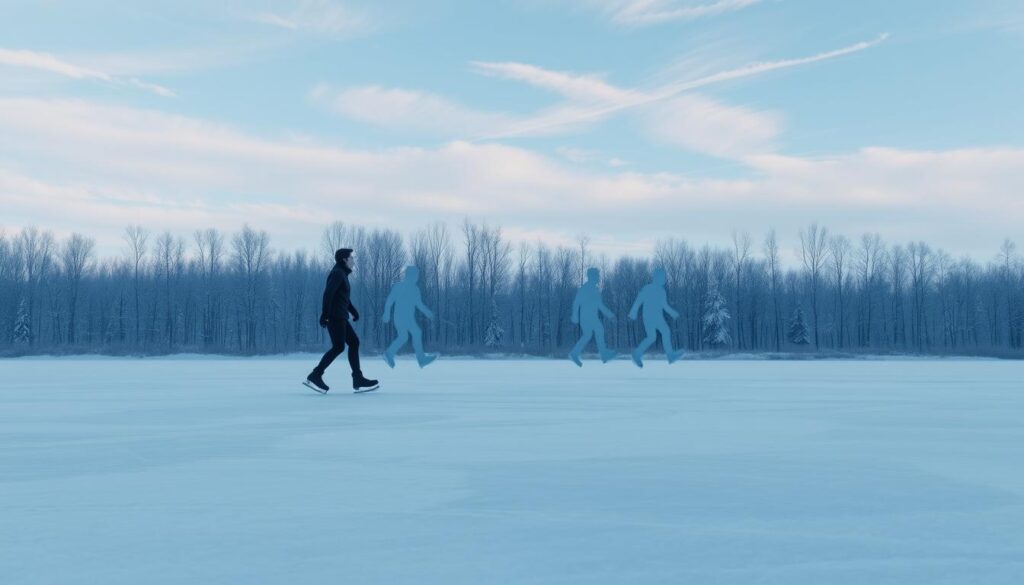
Learning to ice skate is an exciting journey that varies for each individual. The time needed to develop solid ice skating skills depends on several factors. These include your natural athleticism, how often you practice, and your personal commitment.
Many beginners wonder about the typical learning curve for ice skating skills. While progress varies, most skaters can follow a structured pathway to master basic techniques.
Learning Milestones for New Skaters
- Week 1-2: Basic balance and standing on ice
- Week 3-4: Simple forward movement and stopping
- Month 2-3: Comfortable gliding and basic turns
- Month 4-6: Advanced techniques and increased confidence
Recommended Practice Schedules
Consistent practice is key to developing ice skating skills. Here are recommended practice frequencies:
- Casual learners: 1-2 sessions per week
- Dedicated beginners: 3-4 sessions per week
- Aspiring competitive skaters: 5-6 sessions per week
Each session should ideally last 45-60 minutes. Focus on technique and gradual skill progression. Remember, quality practice matters more than quantity when learning to ice skate.
Safety Measures and Injury Prevention
Ice skating for beginners needs a good grasp of safety rules. Keeping yourself safe is key when you start this fun winter sport. Your safety journey begins with the right gear and knowing what to do.
Protective gear is the first step in ice skating safety. Get quality safety equipment to protect you from injuries:
- Helmet (critical for head protection)
- Wrist guards to prevent fractures
- Knee and elbow pads
- Padded skating shorts for hip protection
Doing warm-up exercises helps prevent injuries. Stretch your muscles carefully before stepping onto the ice. Focus on:
- Ankle flexibility exercises
- Leg and hip stretches
- Core strength movements
- Balance training
Being aware of your surroundings is important for rink safety. Always watch for other skaters, keep a safe distance, and learn basic stopping techniques. Beginners should practice in less crowded areas.
Knowing about dangers is vital for safe ice skating. Watch out for:
- Uneven ice surfaces
- Wet or slippery areas
- Crowded skating zones
- Unexpected obstacles
Confidence grows with preparation. Take lessons from professional instructors. They can teach you safe skating techniques and help you build skills slowly.
Progressive Learning: From Basic to Advanced Skills
Learning to ice skate is an exciting journey. As you move from beginner to advanced, it’s key to understand how your skills grow. This helps you improve on the ice.
Your journey in ice skating is planned to help you grow from a new skater to a confident one. Each step builds on the last, making a strong base for harder skills.
Skill Development Phases
The journey to becoming a skilled ice skater has several important stages:
- Foundational Balance: Learning how to stand and balance
- Movement Fundamentals: Getting the hang of moving forward and stopping
- Intermediate Skills: Learning turns and more complex moves
- Advanced Techniques: Trying jumps, spins, and detailed footwork
Goal Setting Strategies
Setting clear goals is key to improving in ice skating. Here are some tips:
- Make specific, achievable goals for each practice
- Break down hard skills into easier parts
- Keep track of your progress in a journal
- Enjoy the small wins along the way
Remember, ice skating is a personal journey. Your progress depends on regular practice, correct technique, and a positive attitude. Everyone learns at their own speed. Focus on your own growth, not comparing to others.
Common Mistakes to Avoid While Learning
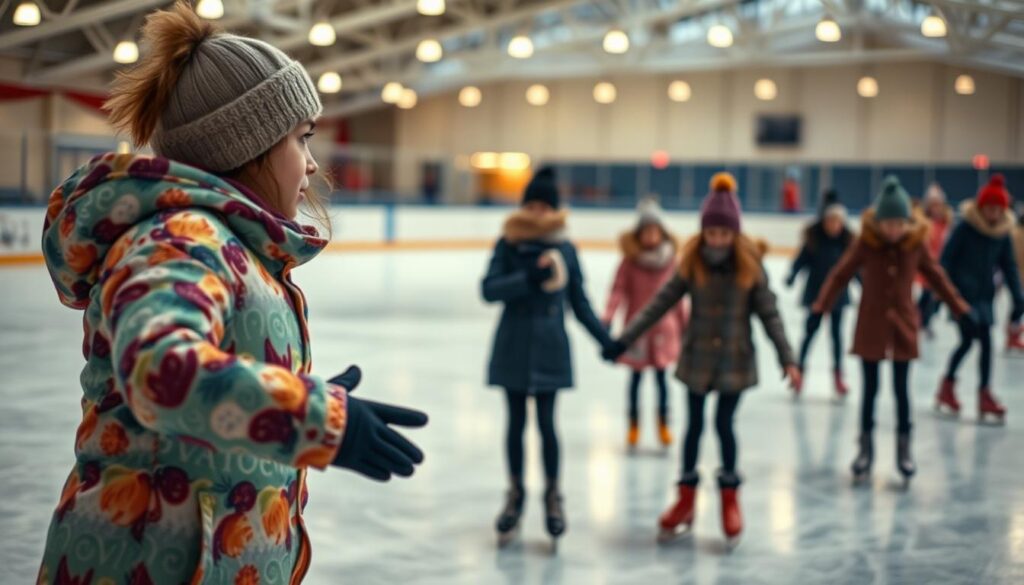
Learning to ice skate can be tough. Beginners often make mistakes that slow them down and hurt their confidence. Knowing these common errors is key to improving and mastering the skill.
Here are the most frequent mistakes new skaters should watch out for:
- Looking Down at Your Feet: This natural instinct actually disrupts your balance and reduces forward momentum
- Incorrect Body Posture: Leaning too far forward or backward can cause unexpected falls
- Gripping the Walls Constantly: Prevents you from developing natural skating balance
- Tensing Up Completely: Stiff muscles make skating more difficult and increase fall risks
Let’s break down some key technical errors that beginners typically make:
| Mistake | Impact | Correction Strategy |
|---|---|---|
| Improper Toe Pick Usage | Unexpected stops and possible falls | Practice controlled toe pick movements |
| Rushing Technique | Poor form and higher injury risk | Focus on slow, deliberate movements |
| Negative Self-Talk | Less confidence and slower learning | Maintain a positive mindset and patience |
Beginner ice skating tips stress the importance of mental preparation as much as physical skill. Remember, every skater begins where you are. Falling is part of learning, not failure. Your aim is steady progress, not immediate perfection.
By spotting and fixing these common errors, you’ll lay a strong base for your skating journey. Stay patient, practice regularly, and enjoy the journey of learning this exciting skill.
Benefits of Taking Ice Skating Lessons
Learning to ice skate can be tough, but with professional help, it becomes fun. Ice skating lessons for beginners make it easier to learn. You’ll gain confidence and skills faster than trying alone.
Professional lessons teach ice skating techniques in a structured way. They give you feedback, safety tips, and help you improve step by step. Self-teaching can’t offer the same level of guidance.
Group vs Private Instructions
Deciding between group and private lessons depends on how you learn best. Here’s a look at both:
| Group Lessons | Private Lessons |
|---|---|
| Lower cost | Personalized attention |
| Social learning environment | Customized skill progression |
| Standard curriculum | Flexible scheduling |
Finding Qualified Instructors
When looking for ice skating lessons, keep these points in mind:
- Certification from recognized skating organizations
- Years of teaching experience
- Specialized training in beginner techniques
- Positive student testimonials
Pro tip for learning to ice skate: Ask instructors about their teaching style and how they work with beginners.
Getting professional lessons speeds up your learning, lowers injury risks, and makes skating more fun and rewarding.
Mental Preparation and Overcoming Fear
Ice skating is more than just physical skills. Your mental approach is key to overcoming challenges and gaining confidence. Fear is common for new skaters, but the right mindset can turn it into an opportunity.
Understanding your fears is the first step. Beginners often fear falling, losing control, or looking awkward. These fears are normal and can be managed with mental preparation.
- Visualization exercises help you mentally rehearse skating movements
- Mindfulness techniques keep you focused and present
- Controlled falling practice builds confidence and reduces anxiety
Building mental resilience is essential for mastering ice skating. Skaters suggest several strategies to strengthen your mind:
| Mental Technique | Benefit |
|---|---|
| Positive Self-Talk | Reduces negative thought patterns |
| Breathing Exercises | Manages performance anxiety |
| Goal Setting | Creates clear progression path |
Remember, every professional skater started exactly where you are now – facing initial fears and working to overcome them. Embrace the learning process, be patient with yourself, and celebrate small victories along the way.
Your mind is your most powerful tool in ice skating. By cultivating a growth mindset and using mental preparation techniques, you’ll not only improve your skills but also enjoy the exhilarating experience of gliding across the ice.
Conclusion
Mastering ice skating is an exciting adventure that turns challenges into triumphs. Many wonder if ice skating is hard. But, every skilled skater began where you are now – eager to learn.
The path to becoming confident on ice is paved with practice, patience, and a willingness to try new things. Your journey into ice skating doesn’t need superhuman abilities. With the right techniques and safety, anyone can glide smoothly on the rink.
From basic posture to advanced movements, each step brings you closer to becoming a proficient skater. The skills you’ve learned are more than just skating techniques. They open the door to a fun, fitness-focused activity that brings joy and challenge to your life.
Whether you’re into recreational skating or dream of advanced performances, your limits are set by your passion and commitment. As you step onto the ice for the first time, remember that every expert was once a beginner. Ice skating can be hard, but it’s also incredibly rewarding.
Your adventure is just beginning, and the rink awaits your first glide. Embrace the challenge, stay dedicated, and enjoy the incredible journey of mastering ice skating.
